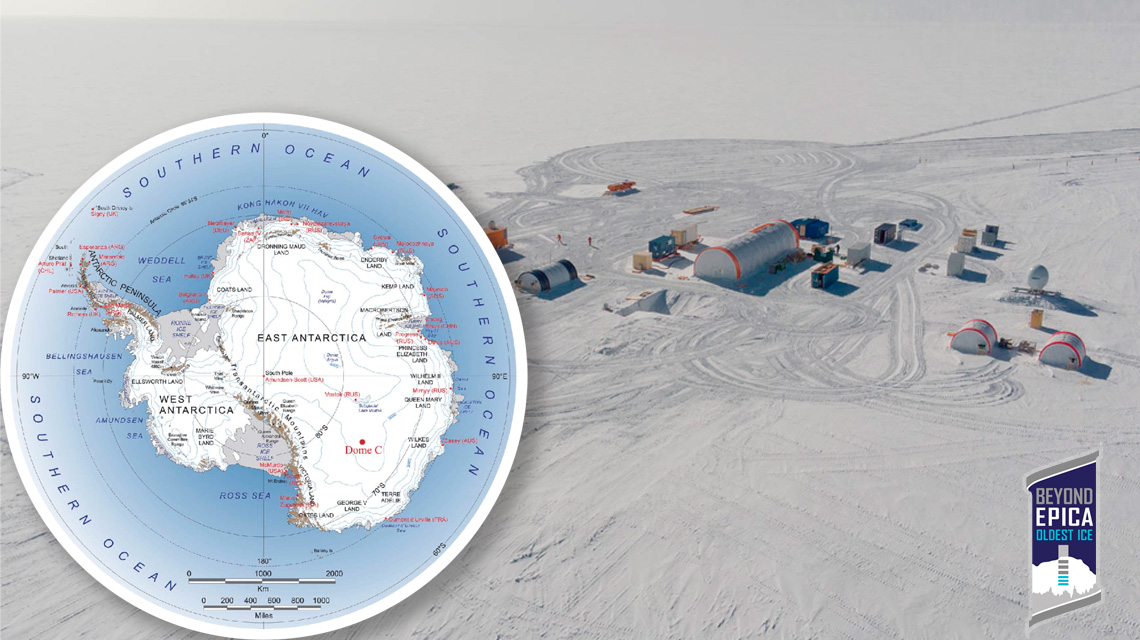Italian National Agency for New Technologies, Energy and Sustainable Economic Development

Antarctica: Beyond Epica second ice core drilling campaign begins
The Little Dome C site in Antarctica has reopened for the second ice core drilling campaign of the international research project coordinated by the Institute of Polar Sciences of the Cnr (National Research Council of Italy). By analysing the ice cores extracted from the deep ice in Antarctica, the project aims to obtain information dating back to 1.5 million years ago, regarding the evolution of temperature, the composition of the atmosphere, and the carbon cycle. The team includes 15 people and aims to start deep drilling to reach depths of a few hundred metres.
As summer in the southern hemisphere draws near, researchers are starting to work again at the remote Little Dome C site in Antarctica. An international team made up of 15 people will begin the deep drilling campaign for the European project Beyond Epica Oldest Ice. They will work for over two months on the Antarctic plateau at 3.200 metres above sea level, where the average summer temperature is -35°C. Over the next few years, the analysis of an ice core extracted from a depth of 2.7 km will enable the reconstruction of the world’s climate history, going back in time by 1.5 million years to discover information on temperature and on the concentration of greenhouse gases in the atmosphere. This project is fundamental for paleoclimatology studies.
The project has been funded by the European Commission with 11 million euros. It is coordinated by Carlo Barbante, director of the Institute of Polar Sciences of the National Research Council of Italy (Cnr-Isp) and professor at Ca’ Foscari University of Venice. The project involves twelve European and non-European international research institutes. On the Italian side, in addition to the CNR and Ca’ Foscari University of Venice, the Italian National Agency for New Technologies, Energy and Sustainable Economic Development (ENEA) is in charge, together with the French Polar Institute (IPEV), of managing the logistics.
The activities of the Beyond Epica Oldest Ice project benefit from a synergy with the research conducted in the framework of the Italian Antarctic Research Programme (PNRA), which is funded by MUR, and coordinated by the CNR (scientific activities) and by ENEA (campaign management).
Little Dome C is an area of 10 km2, located 40 km from the Italian-French Concordia Station — one of the most extreme places on the Earth. This year’s campaign will last until the end of January 2023.
“In the previous campaign, despite the prohibitive weather conditions, with gusts of wind and temperature almost always below -40°C, we set up a campsite that can host up to 15 people for a few months, as well as a complex drilling system,” says Carlo Barbante, who participated in the 2021/2022 campaign. “Our starting point will be 130 metres deep, which is the depth we reached last year. In this campaign we will conduct deep drilling. Our hope is to reach a depth of a few hundred metres by the end of January 2023.”
The climate and the environmental history of our planet is archived in the ice, which can therefore reveal information from hundreds of millennia ago on the evolution of temperature and the composition of the atmosphere. Researchers will be able to assess the content of greenhouse gases, such as methane and carbon dioxide, in the atmosphere of the past link these findings to how the temperature evolved.
“We believe this ice core will give us information on the climate of the past and on the greenhouse gasses that were in the atmosphere during the Mid-Pleistocene Transition (MPT), which happened between 900,000 and 1.2 million years ago,” says Barbante. “During this transition, climate periodicity between ice ages changed from 41,000 to 100,000 years: the reason why this happened is the mystery we hope to solve.”
Here are the members of the 2022/2023 team: Frank Wilhelms, Matthias Hüther, Gunther Lawer, Martin Leonhardt and Johannes Lemburg from the Alfred Wegener Institute (Germany), Robert Mulvaney from the British Antarctic Survey (UK), Julien Westhoff from the University of Copenhagen (Denmark), Romain Duphil from the University of Grenoble-Alpes (France), Romilly Harris Stuart from Laboratoire des sciences du climat et de l'environnement and DEEPICE PhD candidate (France), Giuditta Celli from Cnr-Istituto di Scienze Polari and PhD candidate at Ca’ Foscari University of Venice (Italy), Saverio Panichi, Michele Scalet and Andrea De Vito from ENEA — the Italian National Agency for New Technologies, Energy and Sustainable Economic Development (Italy). Markus Grimmer and Florian Krauss from the University of Bern (Switzerland) will provide support from the Concordia Station.
